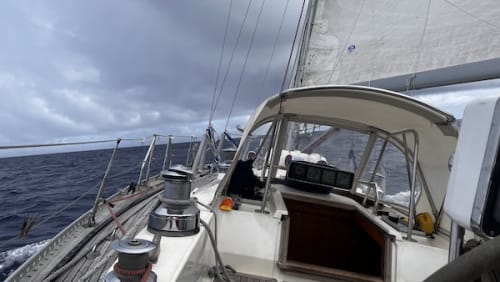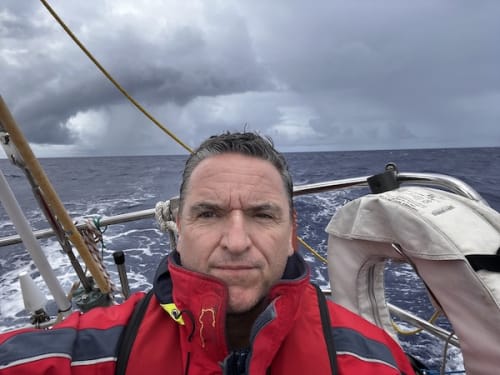In part 1, I shared a bit about why I want to sail offshore so badly and how the opportunity came, went, and came again.
Three Men in a Boat
The return crew of three were Phil, skipper and owner, Jack (a great name for a sailor) the navigator from the race, a highly experienced offshore sailor, and me aka “Roger the Cabin Boy”. As Phil and Jack are of an older persuasion, I was responsible for semi-skilled manual labor. Basically, if a line needed pulling or something needed attention outside the cockpit, that would be my job.
To be honest, I love that stuff!
Captain My Captain
The skipper has a vast responsibility in offshore sailing. First and foremost, the captain is responsible for the safety of the crew in what can be a very dangerous environment. He or she is also responsible for the preparation of the boat, selection, and training of the crew, race entry and administration, logistics, race strategy, provisioning, and working with the navigator on navigation. And this is all before the boat leaves the mooring.
If the captain owns the boat, he is also on the hook to pay for all this. At the risk of stating the obvious, it’s an expensive sport. Possibly only polo and motor racing are more costly.
Once underway, in addition to ensuring that no one is hurt, the captain needs to ensure that the crew has a routine that allows them to eat and sleep enough while still being competitive in the race. He has to think about what could go wrong in any given weather conditions. He needs to make decisions based on the navigator’s recommendations. And, as they are racing, the captain needs a plan to win the race.
The Navigator – It’s Usually This Guy’s Fault
The navigator is a fascinating role. He or she recommends the best course for the boat to win the race, and avoid hazardous sea states and other excessive risks. He has to consider many factors including wind forecasts (direction and speed), sea state (wave heights and wave direction), currents such as the Gulf Stream, the boat’s performance potential, and more.
Navigators look at many different types of data and models from different sources. They typically review the data on an onboard laptop using applications like Expedition. Based on this they will typically present different options to the skipper.
It’s often a thankless task. If the boat wins, everyone had their part to play and the skipper takes the limelight. If the boat does badly, the navigator often gets the blame rightly or wrongly. That said, good navigators are in demand.
Crew – We Have a Little Job For You
It is not unusual for a 40-foot racing yacht to have a crew of 10. This means that in addition to the skipper and navigator there are eight able bodies to execute the various, continuous physical and sometimes precarious tasks required to keep a racing vessel moving fast.
In our case, there was one. Me.
To be fair, we were not racing, we could use our engine to motor, and we were not flying a spinnaker. This latter task requires a small village to execute, physical feats that would terrify a circus acrobat and often quite a lot of harsh language and hurt feelings.
On our passage, we rarely ventured out of the protection of the cockpit, especially when the wind was blowing hard and the boat was moving fast. On half a dozen occasions, I was given an urgent mission that required me to go forward, sometimes crawling on all fours, clipped to a lifeline, on a deck that was moving up and down by 4 feet every 20 seconds, with the threat of a wave washing over deck, to perform tasks that are quite complicated on a stationary boat.
But that’s what I came for and I LOVE it!
And I also made the sandwiches.
Our Vessel – And This Bird You Cannot Change

Phil’s yacht, Freebird is a classic fiberglass yacht with a great pedigree. She was built in the 70s by the Finnish boat builder Nautor Swan based on a Sparkman Stephens design. I will spare you the gory details, but these guys know how to design and build great boats. She is built like a tank but sleek nevertheless. I can’t think of a better boat to sail on in rough offshore conditions.
As a sloop, she carries a big mainsail. For this return trip, we were using a relatively small headsail so that we would not be overpowered. She has 10 winches and more lines than I can count.
Phil has owned Freebird for 37 years and has spared nothing to maintain and equip her to race competitively and be a comfortable boat to cruise on.
 In preparation for the race, Phil completed a list of over 100 tasks that he believed were required for Freebird to be ready to race. This included replacing all the rigging, changing the 12-Volt electrical power to lightweight lithium-ion batteries, and overhauling the diesel engine.
In preparation for the race, Phil completed a list of over 100 tasks that he believed were required for Freebird to be ready to race. This included replacing all the rigging, changing the 12-Volt electrical power to lightweight lithium-ion batteries, and overhauling the diesel engine.
Below decks, Freebird is beautiful with mahogany bulkheads and doors, lots of handles to hold on to when the boat is heeled over and banging around, comfortable berths, a very efficient fridge, a well-functioning head and a freshwater system that uses either electrical pumps or manual foot pumps.
Safety Is the Price of Entry
There is no more important priority for captain and crew in sailing than safety. The preparations for the Bermuda Race are intense. The list of requirements runs to 30 pages. For example, each boat must have a recently certified life raft, and a man-of-overboard system and each boat is inspected before she can start. Each boat must have crewmembers who have taken a 16-hour safety at sea course, and first-aid training and 30% of each crew must have done this.
Phil insisted that each crew member wear an offshore life jacket, with a harness with two tethers to clip on to fixtures on the boat or a jackline. Each jacket should also be fitted with a Man-over-Board (MOB) AIS beacon. This $300 device notifies anyone in the area of your precise location. If I went overboard, Freebird would find me in the dark, in fog, and in heavy waves thanks to this amazing technology.
Freebird’s AIS system allowed us to be aware of any other vessel within at least a 25-mile radius. This provided information about their course, speed, and most importantly how close we would come to each other if both vessels maintained course and speed. Consequently, we would know if there was a risk of collision.
In addition, Freebird had an updated radar system that allowed us to track boats without AIS and also look out for bad weather. Squalls and heavy showers show up on the radar. This gave us time to prepare the boat if a squall was imminent.
Provisioning
The last piece of preparation was provisioning.
Serious offshore racing crews eat freeze-dried meals, mixed up in a giant container, and doled out into dog bowls. I am not making this up.
We were a bit more civilized.
Phil had filled up the freezer with pasta dinners. They were tasty but eating them every night got a little repetitive, especially for Phil and Jack who had eaten them on the race down to Bermuda. We took a run to a little supermarket prior to departure to stock up on cookies, candy, bread, and stuff to make sandwiches for lunch. Breakfast was toast, yogurt, cereal, juice, and coffee.
The only rule was no alcohol. No wine, beer, or liquor until we tied up in Rhode Island. And no rum. This was not a pirate ship for heaven’s sake.
In Part 3, I will tell you about the passage itself.





